Predicting adolescent perfectionism: The role of socio-demographic traits, personal relationships, and media
INTRODUCTION
There is evidence perfectionism is on the rise; studies investigating perfectionism compiled between 1986 and 2015 clearly show young people are more likely to be perfectionists than their predecessors[1]. Perfectionism is characterized by striving for flawlessness, setting excessively high standards for performance, and exhibiting tendencies for overly critical evaluations of one’s behavior[2]. Perfectionism is a multidimensional construct that manifests in forms of excessively high personal standards, exaggerated worries about personal mistakes, doubt in one’s performance, oversized order and organization emphasis, and the importance of parental valuations and expectations[3]. Flett and Hewitt define perfectionism as a pursuit of infallibility where perfectionists are persons who want to be perfect in all aspects of life[4]. Frost[5] define perfectionism as the “setting of excessively high standards of performance in combination with an overall tendency towards critical self-evaluation”[6]. According to Nordin-Bates, Hill, Cumming, Aujla, and Redding (2014, as cited in[7]), perfectionism is considered to be a stable personality trait that influences important areas of an individual’s life[7]. The concept of perfectionism has moved from a unidimensional to a multidimensional approach[8]. Early conceptualizations of perfectionism suggested it was a unidimensional construct, while some authors distinguished between normal and neurotic perfectionism[9]. Normal perfectionism is defined as the tendency for setting real and achievable goals, which lead to increasing feelings of satisfaction and self-esteem. Neurotic perfectionism, on the other hand, consists of setting extremely high goals motivated by fear of failure and anxiety, often due to the possibility of disappointing important close individuals, which consequently impacts personal satisfaction[10].
Don t make promises you can t keep, old girl. He chuckled3 in that self-satisfied I ll believe it when I see it way that always gets me riled. I know you re going to come out of there with useless junk. You always do.
Subsequent authors have affirmed this multidimensional nature with two major dimensions: Perfectionistic strivings and perfectionistic concerns[11]. Perfectionistic strivings embody facets related to perfectionistic personal standards and a selforiented striving for perfection. These were found to be associated with positive characteristics, processes, and outcomes such as conscientiousness, adaptive coping, and positive affect alongside higher levels of subjective well-being and psychological adjustment[12]. Perfectionistic concerns represent neurotic, unhealthy and maladaptive facets of perfectionism, such as concerns over mistakes and doubts about actions[13]. People with dysfunctional perfectionism are likely to avoid highexpectance situations[14]. A newer study proposed three classes of perfectionism after controlling for neuroticism and conscientiousness, described as non-perfectionism, adaptive perfectionism, and maladaptive perfectionism[15]. Recently, these three types of perfectionism were established in different samples of adolescents across the world[16-18]. Other studies (Sironic and Reeve, 2015; as cited in[19]), however, proposed a six-class model after applying a latent class analysis of adolescents. Three of the six classes represented perfectionist subgroups (labeled adaptive perfectionist, externally motivated maladaptive perfectionist, and mixed maladaptive perfectionist), and three represented non-perfectionist subgroups labeled non-perfectionist A, non-perfectionist B, and order and organization non-perfectionist[19].
Established models distinguish between adaptive and maladaptive perfectionism, emphasizing its dual nature. Adaptive perfectionism is often considered as an individual’s advantage, while maladaptive perfectionism predicts non-adaptive behavior and experience. The distinction between adaptive and maladaptive perfectionism, or positive and negative perfectionism, is in the acceptance of personal feelings and thoughts by the individual[20]. Research by Shim[3] shows that adaptive perfectionism is related to higher school achievement, while maladaptive perfectionism is related to lower achievement. Maladaptive perfectionism is characterized by an over-analysis of personal behavior, exceeding concern about criticism and expectations from others, and an imbalance between expectations and outcomes. It is related to maladjustment, negative affect, low self-esteem, and low self-efficiency[21]. Maladaptive perfectionists are motivated by fear of failure and reactions from others if they do not achieve their expectations. This makes them avoid certain situations, for example, providing an answer to a question unless they are completely sure, or procrastination[22]. Studies have found maladaptive perfectionism to be positively related with various forms of psychopathology, such as eating disorders, anxiety, oppressive-compulsive disorders, and depression (Hewitt, 1989; Rasmussen and Eisen, 1992; Thompson, 1987; as cited in[11]).
7.Beautiful, pious girl:Her looks are very important and there is a tendency in stories to have beauty and goodness paired together. The description strengthens the blamelessness and goodness of the girl. In the 812 version, she simply lived though the three years in the fear of God and without sin (Zipes, Brothers, 176).Return to place in story.
Our results on general life satisfaction (Tables 2, 5) show it negatively predicts “Worrying about mistakes“ (< 0.001), while current situational life satisfaction is a positive predictor of “Organization“ (< 0.05). A study by Bilić[61] reported a significant positive correlation between negative perfectionism and loneliness, pessimism, and stress management. The study also found a positive correlation between positive perfectionism and general life satisfaction, optimism, and problem solving. Recent research has shown communal values as less attractive, giving place to higher levels of narcissism, extraversion, self-confidence, and competitive individualism (Twenge, 2001; Twenge, Konrath, Foster, Campbell, & Bushman; 2008; Twenge, Campbell, & Gentile, 2012; as cited in[1]). Young people appear to be more self-interested and spend more time in individual activities for instrumental value or sense of personal achievement, causing a rise in behaviors associated with competition and the attainment of social status, upward social comparison, status anxiety, and materialism as means of perfecting their lives in relation to others (Kasser, Ryan, Couchman, & Sheldon, 2004; De Botton, 2004; Marmot, 2004; Scott, Martin, & Schouten, 2014; Twenge, 2014; as cited in[1]). Not only are they more dissatisfied with what they have, adolescents are also seemingly more dissatisfied with who they are[62]. Platforms such as Facebook, Instagram, and Snapchat have become ubiquitous and very popular in how they allow users to curate a perfect public image[30]. But, rather than alleviate presentational and interpersonal anxieties, studies indicate that exposure to others’ perfect self-representations within social media can intensify one’s own body image concerns and sense of social alienation[63,64].
According to the integrative model of perfectionism, suggested by Flett[2], a number of factors can lead to perfectionism, in accordance with the current[23]. Perfectionism develops under the varying impact of external factors in the family or the surroundings as well as personal factors related to the child’s temper or affection[4]. For example, one study found anxiety and maladaptive perfectionism were both moderately heritable[24]. On a personal level, perfectionism has a key role in the construction of personality traits and is considered a cognitive pattern, facilitating or inhibiting relevant skills. Therefore, while it can inhibit relevant skills such as problem solving or metacognitive regulation, it is also related to high intellectual ability with different potentialities leading to the achievement of excellence[25]. Thus, perfectionism in higher intellectual ability individuals is interpreted as a cognitive style linked to the idea of excellence and performance in academic and different settings, for instance well-being[19]. One worrying trend is that researchers are seeing perfectionism in younger adolescents and even children (Portešová and Urb ánek, 2013; as cited in[1]).
Playing sports taught me early that nothing great happens without discipline, perspiration3 and inspiration. My inspiration came one day when, as a freshman4 at Occidental College, Coach Payton Jordan called me into his office. Jack, he said, I watched you play at Fairfax (High School, Los Angeles) and now here at Occidental. You ve got great potential. You should know, confidentially6, that if you work hard, real hard, you can reach the NFL someday. I walked out of his office on cloud nine, promising7 myself I would work harder than ever. I wasn t going to let down Coach Jordan, or myself.
Families are basic and primary instances of upbringing and socialization that provide the child with first experiences, thus representing a starting point for every future social activity[26]. Frost[5] emphasize the importance of the perception of parental expectations and criticism in the development of these characteristics. Perceived parental criticism is a strong predictor of worrying about mistakes and doubting one’s abilities, while perceived parental expectations positively relate to personal standards. Individuals who perceive parental expectations and criticism on a higher level are more likely to develop neurotic perfectionism. On the other hand, young people who develop adaptive perfectionism have lower levels of concern about mistakes and doubts in personal abilities. Similarly, according to McArdle and Duda (as cited in[27]), adaptive perfectionists perceive parental criticism on a lower level, and parental expectation as more reasonable.
Aside from family, peer interactions have an important influence on adolescent psycho-social development. Perfectionists often exhibit low self-esteem and worry about their appearance, which increases under the influence of their surroundings. It is worth noting that across most studies, healthy/adaptive perfectionism is linked with positive effects, excellence, and higher levels of self-esteem, order, and satisfaction in the relation with peers[25]. On the contrary, unhealthy/maladaptive perfectionism is considered as negative, showing low levels of self-esteem and high levels of anxiety or discrepancy, whereas levels of well-being of non-perfectionism seem to be in between the two other groups[19]. For example, acceptance and better relationships with peers alleviate the need to conform with thinness ideals[28], but research also shows that young people start to express eating disorders so as to be accepted by peers[29]. In relation to general life quality, perfectionism research demonstrated the debilitating nature of socially prescribed perfectionism. Studies have positively linked perfectionism with major psychopathology (anxiety, depressive symptoms, and suicide ideation), while socially prescribed perfectionism also predicted depression symptoms and suicide ideation[1]. Researchers often emphasize that perfectionism is not about high standards, but rather about unrealistic standards. When it comes to the impact of media, fear of failure is often magnified through social media platforms, where mistakes can be costly, while all those “retouched” feeds and posts reinforce unrealistic standards[30]. Through the ever-present media, young people seem to have internalized irrational ideals of the perfectible self that, while unrealistic, are to them eminently desirable and obtainable[1]. The present study investigates the six dimensions of perfectionism in adolescents, with special emphasis on the predictive role of sociodemographic traits and social relationships with family, peers and colleagues as well as the importance of life satisfaction and different media content interests.
MATERIALS AND METHODS
Research aim and problem
The aim of this research is focused on the relation between perfectionism and the quality of family, peer, and college relationships and media usage and habits. The research problem is to examine the predictive significance of socioeconomic variables, the quality of family, peer, and college relationships, as well as adolescent media usage and content interests in researching perfectionism.
Hypotheses
Sociodemographic variables are significant predictors of adolescent perfectionism.
Family, peer, and college relationships quality and life satisfaction quality predict adolescent perfectionism.
A three-model hierarchical regression analysis was used to investigate the relationship between the sociodemographic factors (Model 1), family, peer, and college relationships, personal and situational life satisfaction (Model 2), and media usage and habits (Model 3) with six perfectionism dimensions (Parental expectations, Parental complaining, Doubt in one's own performance, Personal standards, Worrying about mistakes, Organization).
Media usage and content interests predict adolescent perfectionism.
Participants
The research was implemented in 2020 with 203 students enrolled at study programs in humanities, social sciences, medicine, economics, law, kinesiology, electrical engineering, computer science, and information technology in Osijek, Croatia. There were 134 female (66%) and 69 male participants (34%), aged 18 to 25 (0-18, 5%; 10-19, 8%; 18-20, 2%; 21-26, 1%; 17-22, 2%; 19-23, 2%; 4-24, 9%; 3-25, 0%).
Instrument
The questionnaire consisted of five parts. Thehad questions on sociodemographic data related to gender, age, type of study program, and academic year. Theconsisted of the Multidimensional Perfectionism Scale (Frost[5]), with 35 statements on perfectionism through six dimensions. The instrument demonstrated a high Cronbach’s alpha reliability score (α = 0.90) and was previously translated into Croatian (Crnčić, Nakić, and Roso, 2006; as cited in[31]). Participants responded using a five-degree Likert scale (1: I do not agree at all; 2: I mostly disagree; 3: I neither agree nor disagree; 4: I mostly agree; and 5: I completely agree). The items on each scale were later transformed into composite variables (family life quality; peer relationships quality; college relationships quality; media usage intensity; informationeducational media content; negative media content; entertainment content).
Our second hypothesis (H2) anticipated family, peer, college relationships quality, and life satisfaction quality as predictors of adolescent perfectionism. The results show that family relationship quality (Tables 1, 3, 5, and 6) negatively predicts “Parental expectations“, “Parental complaining“, “Doubts in one's own performance“, and “Worrying about mistakes“ (< 0.001). Our results are in line with a study on adaptive perfectionism, which showed it was correlated with numerous positive family variables, as adaptive perfectionists tended to have more balanced, cohesive, adaptable families, with a greater perception of parental nurturance than either maladaptive perfectionists or non-perfectionists[37]. It is important to emphasize that children who perceive parental expectations and criticism on a very high level more often develop neurotic perfectionism (high concern of making mistakes, doubt in their own abilities, and lower personal standards)[38]. A number of studies confirm that perfectionism is key for understanding a number of psychological questions in the academic surrounding, including depression, anxiety, hopelessness, eating disorders, and academic procrastination, often manifested as worrying about mistakes, parental expectations, parental complaining, and doubts in one’s own actions[39]. Perfectionist parents have high expectations, personal standards, and concern with failure for both themselves and their children, and those traits may lead to contingent approval and intrusive parenting[40,41]. Such parents are often unable to adjust sensitively and empathically to their children's needs and expectations, evaluate the child's behavior in a critical manner, and engage in psychological control that is an indicator of parenting styles[42].
Thehad the “General life satisfaction” scale with 20 items (Larsen, as cited in[32]) on general satisfaction (Bezinović, as cited in[32]), positive attitude towards life (Groh, as cited in[32]) and a “Current situational life satisfaction” scale. The Cronbach’s alpha coefficient analysis showed satisfactory reliability (α = 0.86).
At last one of the other animals overheard him, and called out, Little hare, little hare! what is that you are saying? But the little hare hastily replied, I only asked you to pass me my stick
Our results on the quality of peer relationships (Tables 3, 5) show that they negatively predict “Doubt in one's own performance“ and “Worrying about mistakes“ (< 0.05). In adolescence, when teenagers are constructing their identity, wanting to be perfect or perceiving that others are demanding perfection increases vulnerability toward socio-cultural models of success and beauty, it appears girls are more vulnerable than boys[52]. Peer influence, in the form of direct comments or modeling, is stronger in adolescence compared with other age groups[53]. A study by Nanu and Scheau[54] showed that adolescent girls with low resistance to peer influences were more tempted to promote a perfectionist self and to hide imperfection. Ommundsen[55] implemented a study with 1719 adolescent athletes (1231 male) aged 12-19 years on the perceived peer acceptance and quality of friendship, perceived motivational climate, achievement goals, and perfectionism in sports. Girls reported constructive peer relations and scored positively on companionship and perceiving friends as being loyal and allowing of free discussion and reported higher social acceptance by peers. Young male players who perceived the motivational climate as predominantly performance oriented and had a moderately negative score on task orientation, but a quite strong positive score on maladaptive perfectionism, reported negative relationships with peers in terms of these aspects. They also reported conflicts with their best sports friend, suggesting that the qualities of motivation have a systematic relationship with peer acceptance and the quality of friendship in male and female youth sports.
Theconsisted of questions on media usage and content interests with 20 items (seven items on the frequency of usage and 13 items on information-educational, negative, and entertainment media content), reporting a satisfactory reliability Cronbach’s alpha coefficient (α = 0.70).
Procedure
The research was implemented in May 2020an online Google docs survey. The questionnaire was forwarded to various student Facebook groups and representatives of Student Councils at all the included university institutions. The results were analyzed using SPSS v.20 (Armonk, NY, United States) with descriptive and inferential statistical procedures.
Away! out with him! At last she came to the row in which the brother who knew the dictionary by heart was, but he did not know it any longer; he had quite forgotten it in the rank and file
One possible shortcoming of this research, which should be mentioned, is that the research was conducted during the coronavirus disease 2019 pandemic, and, therefore, the results should be considered with caution. The sample size was rather modest, so conclusions of a greater scale are limited.
Data Analysis
The Fairy of the Beech-Woods ran to welcome the Prince and Princess with open arms, only too delighted to find them so much improved that she could, with a clear conscience, begin to spoil them again
RESULTS
Our results have demonstrated that age and gender are predictors of perfectionism (Tables 1-4). No significant predictive effects for gender were found in relation to “Parental complaining“, “Worrying about mistakes“, and “Organization“ (Tables 2, 5, and 6). Our results indicate age is a significant predictor of “Personal standards“ (< 0.01) and “Organization“ in older adolescents (Tables 2, 3). The results of our study also demonstrated that family relationship quality (Tables 1, 3, 5, and 6) negatively predicts “Parental expectations“, “Parental complaining“, “Doubts in one's own performance“, and “Worrying about mistakes“ (< 0.001). The results on the quality of peer relationships (Tables 3, 5) indicate that they negatively predict “Doubt in one's own performance“ and “Worrying about mistakes“ (< 0.05). Our analysis on college relationships quality (Tables 2, 4) demonstrated that they positively predict the dimensions “Personal standards“ (< 0.05) and “Organization“ (< 0.001). Our results on general life satisfaction (Tables 2, 5) indicate it negatively predicts “Worrying about mistakes“ (< 0.001), while current situational life satisfaction is a positive predictor of “Organization“ (< 0.05). Our findings did not establish a significant effect for media usage intensity in relation to the six examined dimensions of perfectionism, but the types of media content and media habits were significant predictors of perfectionism in our research sample (Tables 2, 4, and 5). Our results show that the dimension “Personal standards“ positively predicted a higher interest in information-educational media content (< 0.05). The dimension “Worrying about mistakes“ positively predicted a higher interest in both information-educational media content (< 0.05) and entertainment media content (< 0.001). The dimension “Organization“ positively predicted a higher interest in information-educational media content (< 0.01) and negatively predicted the interest for negative media content (< 0.001).
Only the pretty little articles of clothing, they were at first astonished, and then they showed intense delight: Elves and brownies have a complicated relationship with clothing, especially in English folklore
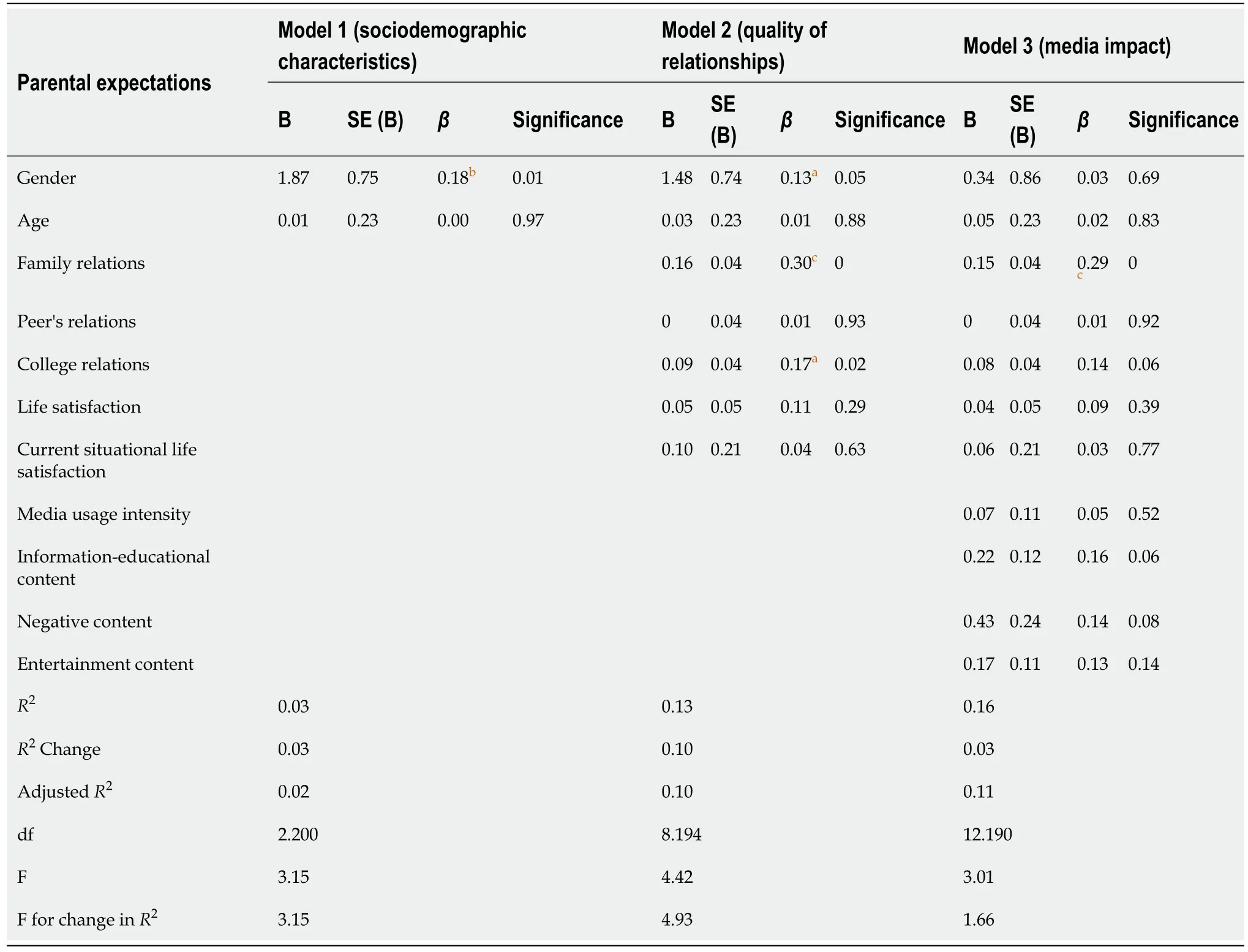
DISCUSSION
The first hypothesis (H1) anticipated sociodemographic variables to be significant predictors of adolescent perfectionism. Our findings show age and gender were established as predictors of perfectionism. Gender predicts higher “Parental expectations“ and “Personal standards“ for girls (< 0.01) but a higher “Doubt in one's own performance“ for boys (< 0.001) as well (Tables 3, 4). No significant predictive effects for gender were found in relation to “Parental complaining“, “Worrying about mistakes“, and “Organization“ (Tables 2, 5, and 6). In a clinical study of social phobic patients in relation to the “Concern Over Mistakes“ dimension and the “Doubts About Actions“ dimension[5,33], age and gender were not shown to be significant factors in the relationship between perfectionism and psychological states. Similarly, an Australian study on a sample of 405 students focused on the relation between perfectionism, stress, anxiety, and general health quality. The study reported no significant effects for age and gender in relation to perfectionism nor was there a significant interaction effect, with the exception of “Stress“[34]. Our results show age as a significant predictor for “Personal standards“ (< 0.01) and “Organization“ for older adolescents (Tables 2, 3). Schweitzer and Hamilton[34] emphasized that, although age and gender were not significant in their predictive model for depression and anxiety, the result differed for stress, suggesting that older students with higher levels of perfectionism may be more affected by stress. Similarly, Parker and Adkins[35] and Frost and Steketee[36] did not establish significant age or gender effects in perfectionism scores. Still, Bulog[27] reported gender differences in perfectionism, as young men (9, 82) expressed higher levels of doubt in their own performance than young women (11, 15) and set higher personal standards (24, 18) than young women (20, 90).
It is not the same thing. In this chair, I can move by myself; I can go anywhere I need to go. That boat traps me so I can t do anything ?nbsp;I couldn t even save myself if something happened and I fell out.
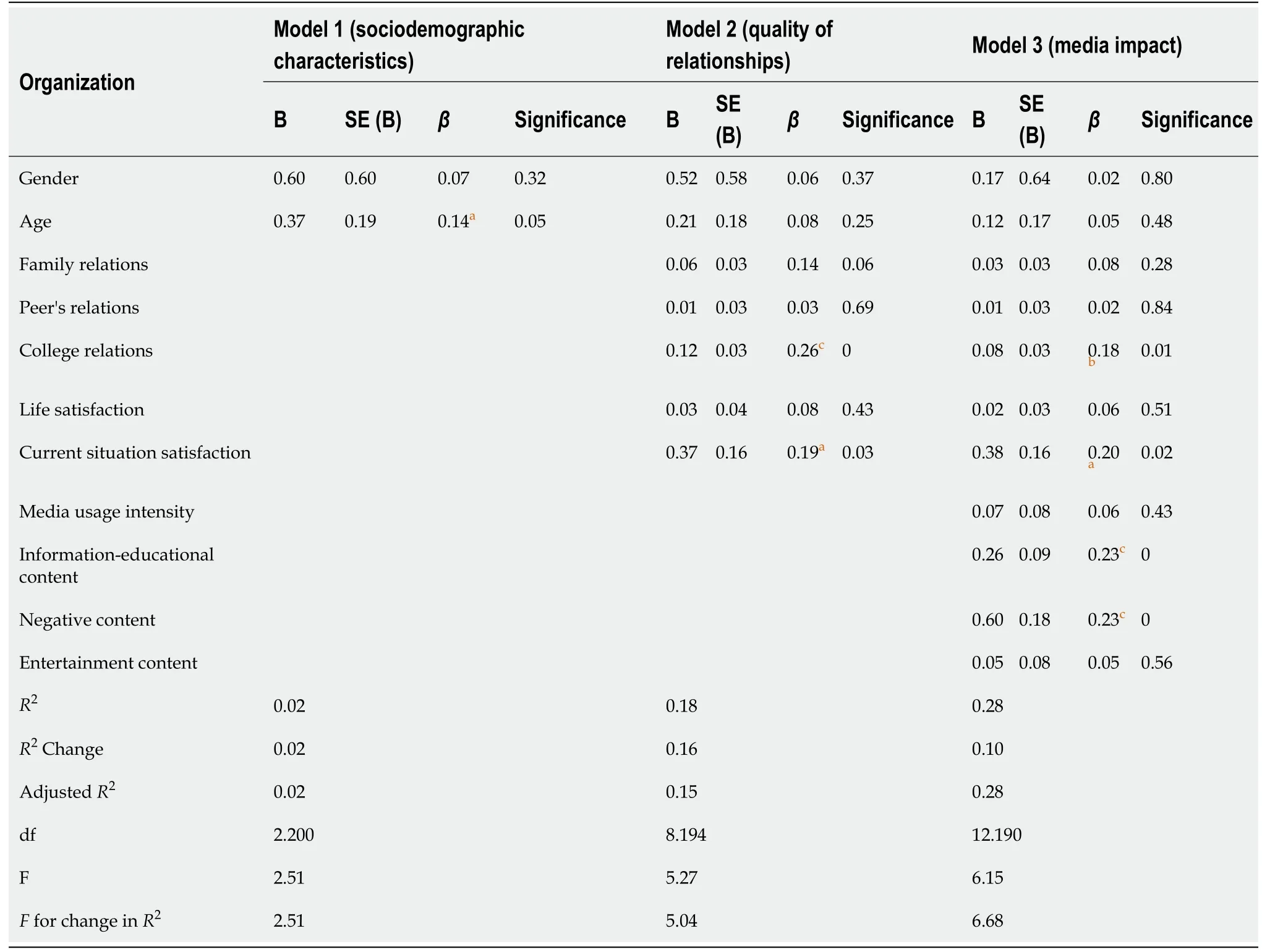
The dimensionconsisted of seven items and was conceptualized as very high personal standard and over seized importance, which was added to those high standards during self-evaluation. The second dimensionwas examined through nine items and was conceptualized as negative reactions to mistakes, tendency to interpret mistakes the same as failures, and tendency to believe that a person will lose respect of the others after failure. The tendency to believe that one’s parents set high goals and that they are too critical, formed the dimensions(five items) and(four items). The dimensionconsisted of four items and described feelings of insecurity in one’s own actions or opinions as well as a tendency to feel that tasks were not completed good enough. The last dimension was(six items), with an emphasis on the importance and preference of order and organization.
Bulog[27] indicates an example of children who often deliberately accept parental expectations as positive component of upbringing, when the parent’s behavior is supporting. Another possibility is the contingent self-worth found in perfectionists[43,44], dependent on specific achievements or expectations. Such parents may condition love and acceptance of their children in relation to the level in which children accept the parents' standards, norms and expectations[45,46]. Curran and Hill[1] claim today's neoliberal and meritocratic doctrine shaped a culture that expects everyone to perfect themselves and their lifestyles by striving to meet unrealistic achievement standards. For parents, this new culture confers an additional burden- along with their own duty to succeed, they are also responsible for the successes and failures of their children[47]. This internalized concern for one’s child’s success has been labeled childcontingent self-esteem[48] and is evident in the rise of parental expectations for their children’s achievements, which, across the industrialized world, are at extremes that psychologists have noted are cause for concern[49]. The role of parents and peers can be analyzed through the model of perfectionism development, which emphasizes the relational context and social connections responsible for the formative experiences of children and adolescents[50]. They view the development of perfectionism to be underpinned by asynchrony, or mismatch, between attachment needs of belonging and self-esteem and responses to those needs.
Our third hypothesis (H3) anticipated adolescent media usage intensity and media content interests as significant predictors of perfectionism. Our results did not establish a significant effect for media usage intensity in relation to the six examined dimensions of perfectionism, but the types of media content and media habits were significant predictors of perfectionism in our sample (Tables 2, 4, 5). Our study shows the dimension “Personal standards“ is positively predicted for adolescents who report more interest in information-educational media content (< 0.05). The dimension “Worrying about mistakes“ is positively predicted for participants who report more interest in both information-educational media content (< 0.05) and entertainment media content (< 0.001). The dimension “Organization“ is positively predicted for participants who report more interest for information-educational media content (< 0.01) and negatively predicted for participants who report an interest for negative media content (< 0.001). Even though research on the relation between specific media content and perfectionism is rare, previous studies have shown that students from gymnasiums (who enroll at universities more often) reported significantly less interest for negative media content (violence, pornography, horror movies). Similarly, gymnasium students reported a significantly higher interest in informationeducational content (news, magazines, documentaries, informative web-sites), with higher academic achievement positively correlating to the students' interest for information-educational media content[26]. Therefore, it is plausible to assume that perfectionist adolescents strive towards educational media content that provides relevant information and facilitates their short-term and long-term academic goals and tendencies, especially in college surroundings. It could also manifest their desire to keep in touch with current social trends and organize their lives or activities accordingly.
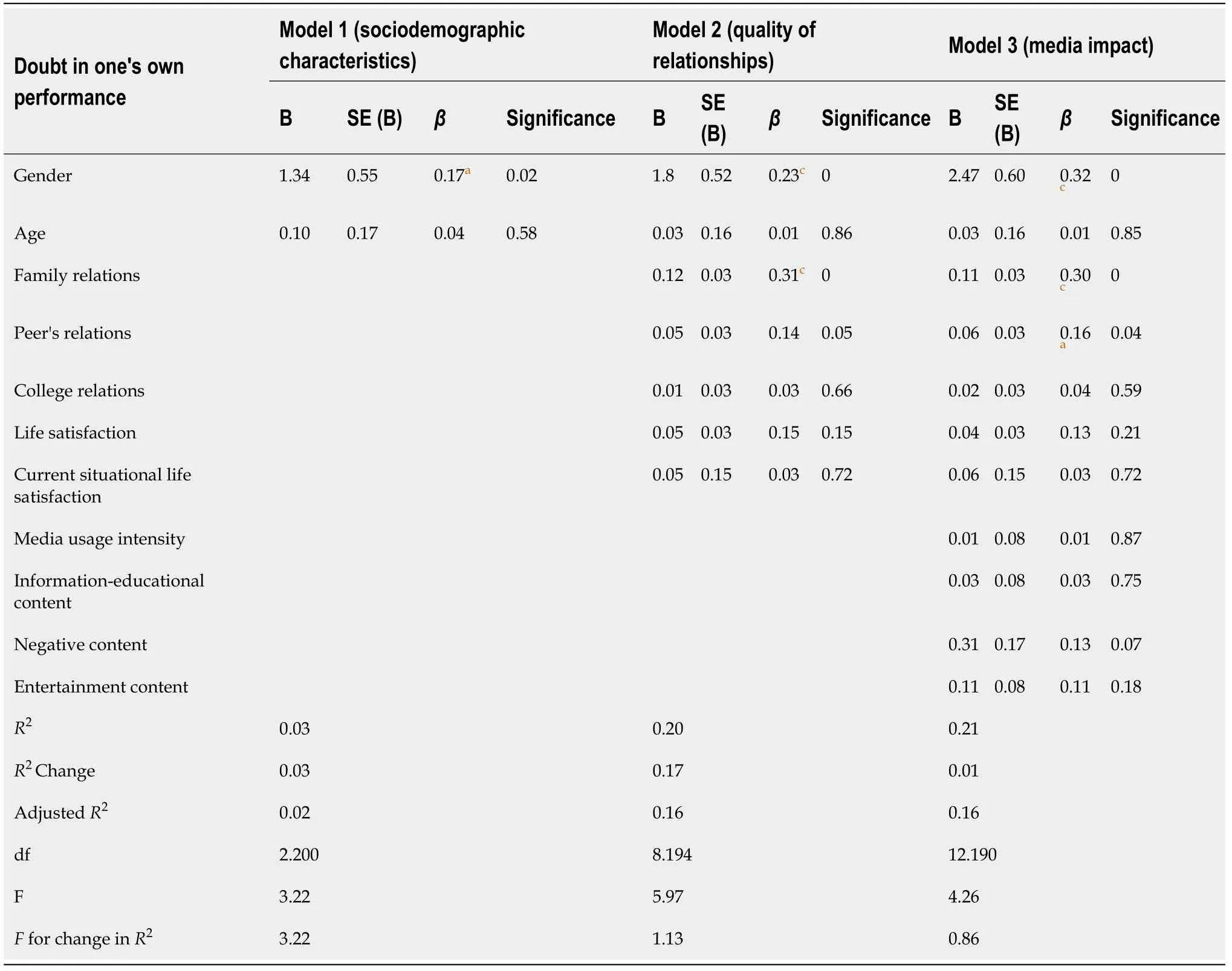
Sutlović and Raboteg-Šarić[51] conducted a study to determine to what extent the quality of devotion to parents is associated with various aspects of perfectionism in adolescents. The results showed that devotion to the mother and father are significant negative predictors of overall perfectionism and non-adaptive dimensions of perfectionism (worrying about mistakes and doubts in one's own performance, parental expectations and complaining) and significant positive predictors of adaptive dimensions of perfectionism (organization). Students who perceive having good family support also have lower personal standards, are less concerned about mistakes, and do not find their parents too demanding and overly critical but are also prone to question the quality of their own actions. Rice and Mirzadeh (2000; as cited in[51]) claim that the less critical and demanding parents are and the more consistent they are in meeting the child's needs, the more likely the child is to develop adaptive perfec-tionism and establish a quality affectionate relationship with them.
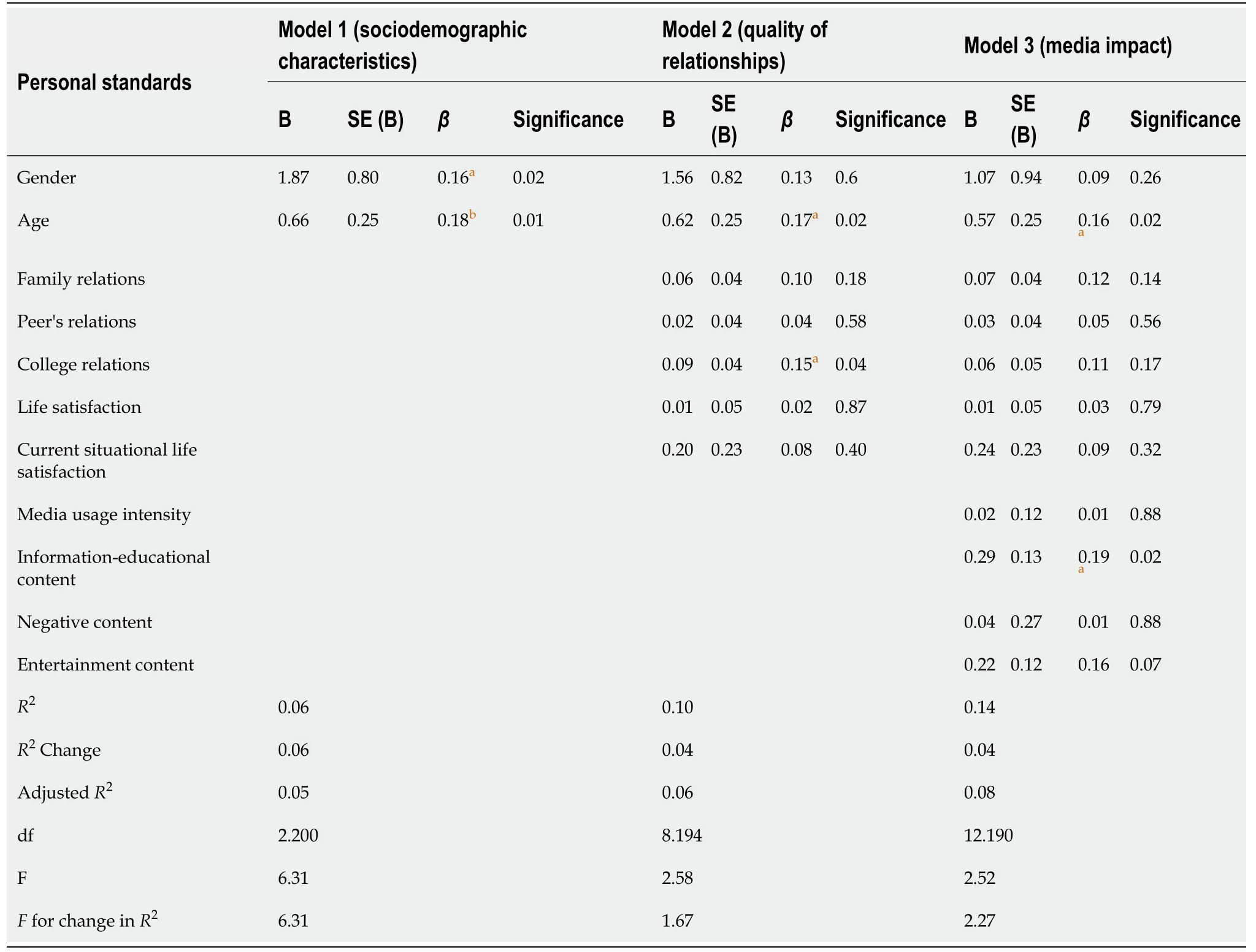
Thehad questions about family, peer, and college relationships quality with 45 statements. The family relationships scale had 13 items (α = 0.75), the peer relationships scale had 18 items (α = 0.79), and the college relationships scale had 14 items (α = 0.84).
Our results on college relationships quality (Tables 2, 4) show that they positively predict the dimensions “Personal standards“ (< 0.05) and “Organization“ (< 0.001). It seems likely that college represents a surrounding that can promote competition and social or academic comparison. Increasingly, studies show perfectionism is not a professional trait one would necessarily want to advertise, as it can actually negatively affect the workplace or professional climate, alienate colleagues, and make teams getting along more challenging[56]. While Hill and Curran[57] claim perfectionists have been found to be more motivated and conscientious than their non-perfectionist peers, studies indicate that Millennials or Gen Z perceive others as expecting more from them, along with simultaneously having higher expectations of themselves and those around them. Perfectionism and perfectionistic self-presentation are related to several important mental health outcomes in college students. The reasons are related to the fact that perfectionism is prevalent among college students, especially for those to whom academic performance is crucial for academic adjustment[58], considering the fact that perfectionism is an important predictor of student adjustment and wellbeing. A study with 312 undergraduate students found that maladaptive perfectionists had significantly worse emotional, academic, and social well-being when compared to adaptive perfectionists[59]. These findings are important due to the fact that student adjustment has been correlated with their academic success and the likelihood of dropping out of college[60].
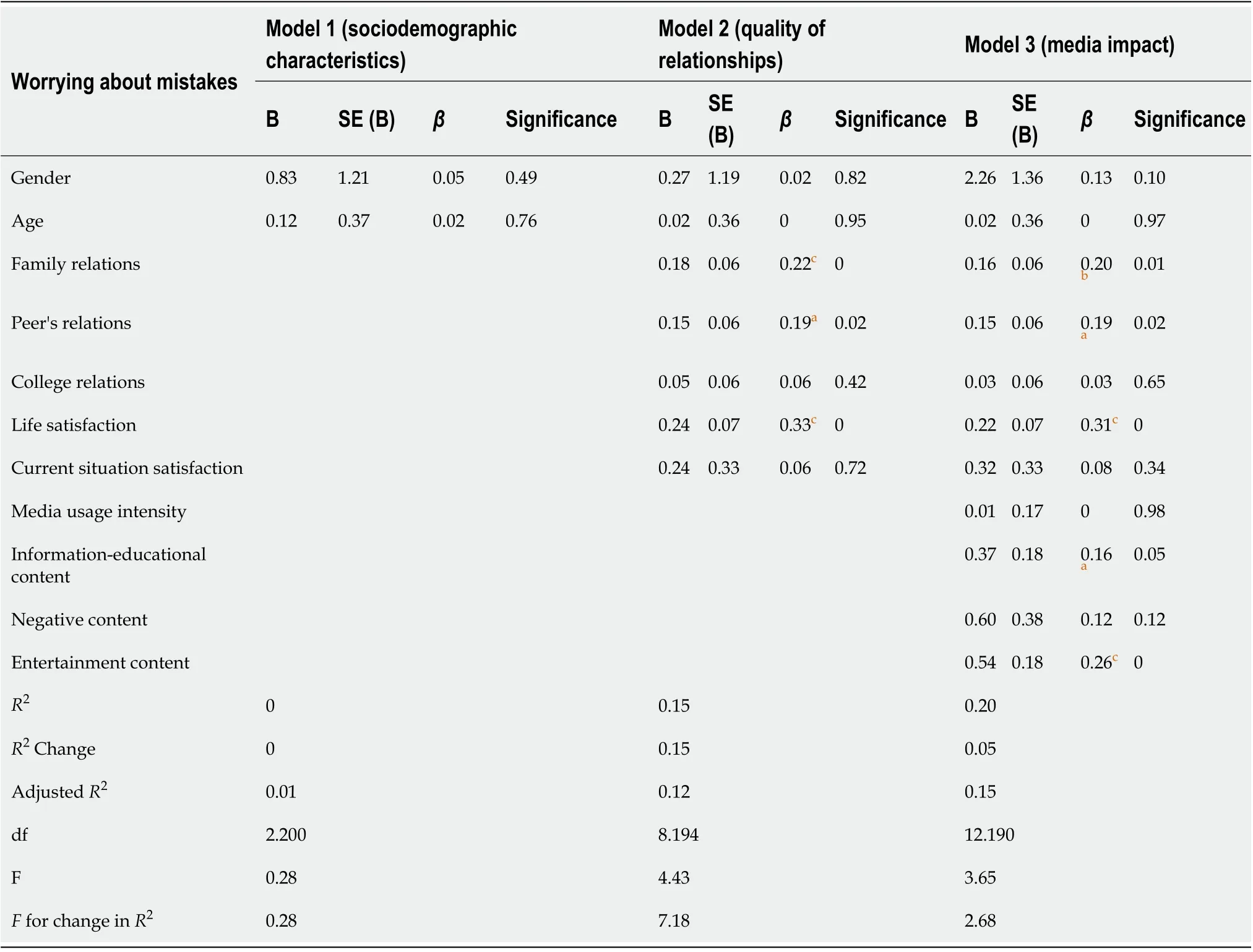
Well, I remember you, too, he grinned. You want to be schoolteacher, I think you said first or second grade, you re putting yourself through college by working here at night and your name is Melinda.
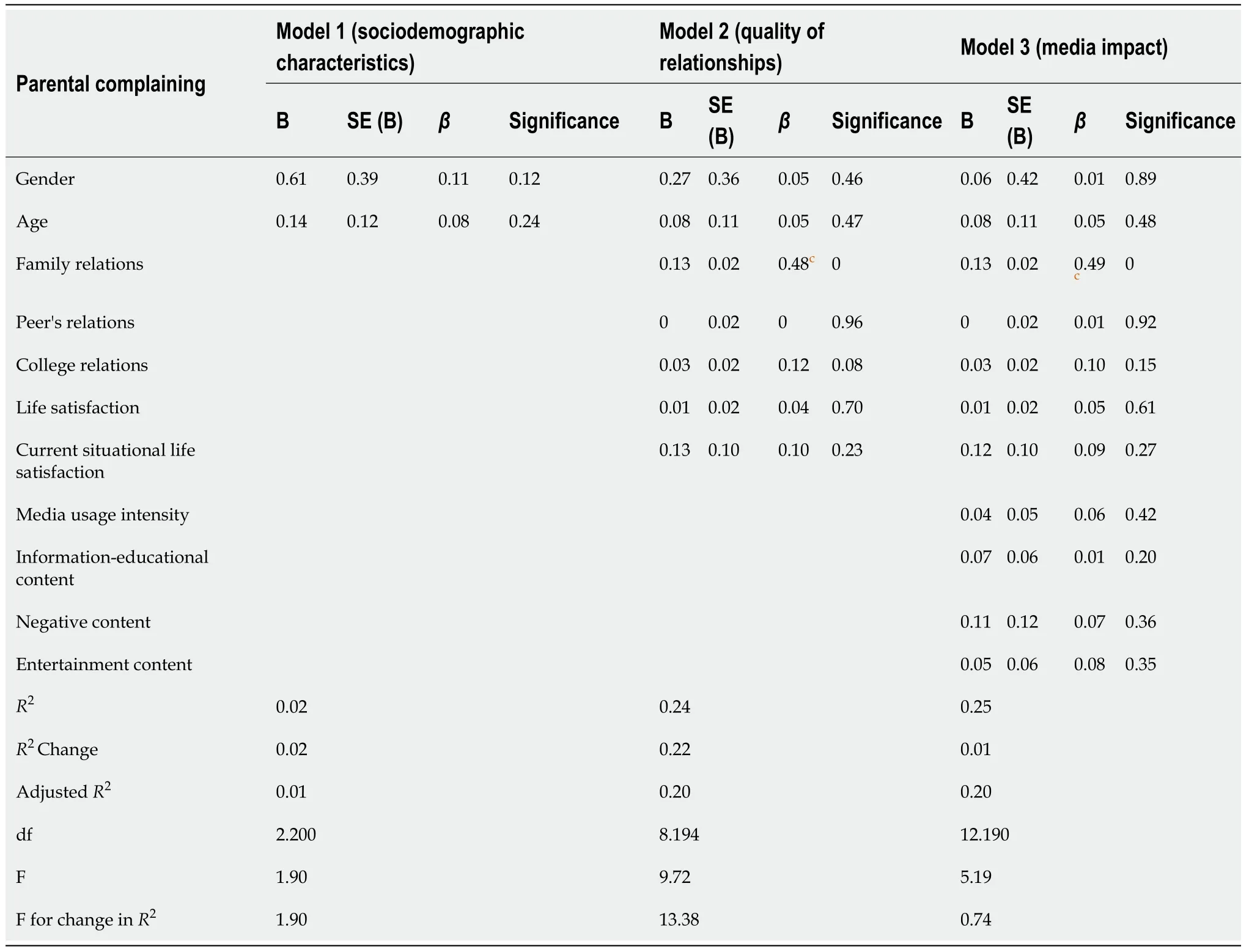
You are the person, said the King, and you have passed sentence on yourself; and even so it shall be done to you. 45 And when the sentence had been carried out the young King was married to his real bride, and both reigned37 over the kingdom in peace and happiness.46
Entertainment media, among them social networks, lifestyle or fashion shows, sitcoms, and “reality format“ outlets, positively predict anxiety about personal mistakes in our sample, which could be related to the social comparison model and the fact that these media formats usually promote unattainable and artificial standards or role-models. There is also a possibility that social networks serve as a comparison platform in relation to peers. For example, a study on 70 undergraduate adolescents investigated the relationship between Facebook use and the well-being of college students, establishing that the number of Facebook friends one had was related to poorer academic adjustment and social adjustment, which thus impact overall adjustment and well-being of students[65]. Nigar and Naqvi[66] described a model by Tiggemann and McGilla (2004), which accurately demonstrated that the negative relationship between perfectionism and body satisfaction is controlled by media content. Similarly, a study by Vartanian[67] established the level of exposure to “media messages about the ideal body type” as the most significant predictor of total body satisfaction. These social influences can be particularly critical in adolescence[68]. By creating a social hierarchy that fuels narcissism and self-obsession, reinforcing cultural models of perfection becomes more available, thus increasing anxiety through feelings of deficiency. Such cultural models of perfection promote the idea that someone is always better in one way or another, which leads to the inevitability of social comparison and consequent stress, pressure, and feelings of inadequacy.
CONCLUSION
The findings presented in our study have important social, pedagogical, and clinical implications for the assessment and treatment of young adults with psychological disorders in the university setting. Our findings established age and gender as significant predictors of perfectionism. Gender predicted higher parental expectations and personal standards for girls but stronger doubts in personal performance for boys, as well. Our study also found that family relationship quality negatively predicted parental expectations and complaining as well as doubts in personal performance and concerns about mistakes. When it comes to peer relationships quality, we found that peer relationships negatively predicted doubts in personal performance and concerns about mistakes in adolescents. Our results on general life satisfaction showed it negatively predicts concerns about mistakes, while the current situational life satisfaction was found to be a positive predictor of organization in perfectionist youth. Even though this study did not establish a significant effect for media usage intensity in relation to the examined dimensions of perfectionism, the types of media content and media habits were significant predictors of perfectionism in our sample. In total, our regression model explained 16% of variance for “Parental expectations“, 25% of variance for “Parental complaining“, 21% of variance for “Doubt in one's own performance“, 20% of variance for “Worrying about mistakes“, 14% for “Personal standards“, and 28% of variance for “Organization“. In reflecting on the findings, we must emphasize the practical implications and potential social, psychological, educational, or health difficulties often related to an increase in perfectionism. Around the developed world, global health estimates claim that serious mental problems afflict a record number of young people, with increasing levels of depression, anxiety, and suicide ideation as well as more loneliness, eating disorders, and various addictions in comparison to a decade ago (Thompson & Durrani, 2007; Patel, Flisher, Hetrick, & McGorry, 2007; Smink, 2012; Paik & Sanchagrin, 2013; Bor, Dean, Najman, & Hayatbakhsh, 2014; Bloch, 2016; WHO, 2017; as cited in[1]). In the context of metaanalytic data, the observed increases in perfectionism have the potential to explain a surge in the prevalence of psychopathology[1,69,70]. For educators, clinicians and related professionals, learning about novel characteristics of perfectionism is crucial due to the complexity of this phenomenon. Adolescents are a very vulnerable population growing up under strong personal and social achievement pressure, potentially hazardous for their value development, self-esteem, and behavior. Due to permanent exposure to “polished virtual lives”social media, many adolescents become victims of personal dissatisfaction and the “fear of missing out”. From a cultural, social, educational, or clinical point of view, perfectionism is generally still modestly researched. Such research findings could clarify general and specific risk or protective factors, thus enabling an overview of the characteristics and role of certain dimensions or forms of perfectionism, with the goal of successful and timely prevention and treatment.
ARTICLE HIGHLIGHTS
Research perspectives
Future research should focus on the role of adolescent media usage and interests, as well as the protective role of family, school, peers, and leisure time in adolescent perfectionism etiology.
Research conclusions
The findings presented in our study have important social, pedagogical, and clinical implications for the assessment and treatment of young adults with psychological disorders in the university setting. More research on the relation between the examined variables is needed, but our results indicate a significant role of sociodemographic traits, social relationships quality, and the impact of media on adolescent perfectionism.
Research results
Age and gender predicted adolescent perfectionism. No significant predictive effects for gender were found in relation to “Parental complaining“, “Worrying about mistakes“, and “Organization“. Age is a significant predictor of “Personal standards“and “Organization“ in older adolescents. The family relationship quality negatively predicted “Parental expectations“, “Parental complaining“, “Doubts in one's own performance“, and “Worrying about mistakes“. The quality of peer relationships negatively predicted “Doubt in one's own performance“ and “Worrying about mistakes“. College relationships quality positively predicted “Personal standards“ and“Organization“. General life satisfaction negatively predicted “Worrying about mistakes“, while current situational life satisfaction positively predicted“Organization“. No significant effects were established for media usage intensity in relation to the six examined dimensions of perfectionism, but the types of media content and media habits were significant predictors of perfectionism.
Research methods
The research was implemented in 2020 during the coronavirus disease 2019 pandemic with 203 participants in Croatia. There were 134 female (66%) and 69 male participants(34%), aged 18 to 25 years. The online questionnaire consisted of five parts. The results were analyzed using SPSS v.20 with descriptive and inferential statistical procedures.A three-model hierarchical regression analysis was used to investigate the relationship between the sociodemographic factors (Model 1), family, peer, and college relationships, personal and situational life satisfaction (Model 2), and media usage and habits (Model 3) with six perfectionism dimensions (Parental expectations, Parental complaining, Doubt in one's own performance, Personal standards, Worrying about mistakes, Organization).
Research objectives
The aim of this research is focused on the relation between perfectionism and the quality of family, peer, and college relationships and media usage and habits. The research problem is to examine the predictive significance of socioeconomic variables,the quality of family, peer and college relationships, as well as adolescent media usage and content interests in researching perfectionism.
Research motivation
From a cultural, social, educational, and clinical point of view, perfectionism and its impact on adolescents and society in general is still generally modestly researched.The authors aimed at examining the possibilities of predicting adolescent perfectionism in relation to the most important risk-protective dimensions. Adolescents are a very vulnerable population growing up under strong personal and social achievement pressure, potentially hazardous for their value development, self-esteem, and behavior. Due to permanent exposure to “polished virtual lives”social media, many adolescents become victims of personal dissatisfaction and the “fear of missing out”.
Research background
The research study examined perfectionism as a multidimensional construct. The study design on adolescent perfectionism included forms of excessively high personal standards, exaggerated worries about personal mistakes, doubt in one’s performance, over-sized order and organization emphasis, and the importance of parental valuations and expectations. Our research was focused on examining the relation between sociodemographic traits, perfectionism, the quality of family, peer, and college relationships, and media usage and content interests.
ACKNOWLEDGEMENTS
The authors would like to extend their gratitude to all the institutions and participants involved, due to the research being implemented during the coronavirus disease 2019 pandemic. We extend our gratitude to Ajla Dizdarević for language-proofing the paper.
World Journal of Clinical Cases2022年1期
- World Journal of Clinical Cases的其它文章
- Hepatitis B virus reactivation in rheumatoid arthritis
- Paradoxical role of interleukin-33/suppressor of tumorigenicity 2 in colorectal carcinogenesis: Progress and therapeutic potential
- Changes in rheumatoid arthritis under ultrasound before and after sinomenine injection
- Benefits of multidisciplinary collaborative care team-based nursing services in treating pressure injury wounds in cerebral infarction patients
- Outcomes and complications of open, laparoscopic, and hybrid giant ventral hernia repair
- Surgical resection of intradural extramedullary tumors in the atlantoaxial spine via a posterior approach
